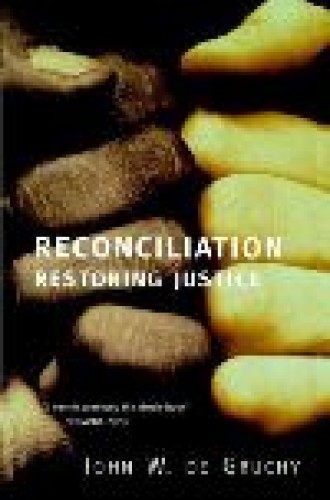Evil consequences
How was it possible for 40 million South Africans to avoid a disastrous civil war and create a new society that raised the hope for peace among long-alienated peoples? Those familiar with the country believe that the answer is twofold: a rigorously negotiated constitution shaped around human rights and citizen participation in political decisions; and a Truth and Reconciliation Commission that walked the narrow boundary between exacting vengeance on the agents of the apartheid regime and granting them immunity.
It has become almost fashionable in South Africa to dismiss the TRC for failing to produce the “reconciliation” side of its announced mission. Can the word “reconciliation” be used with theological, ethical and political-empirical integrity? John de Gruchy and Puma Gobodo-Madikizela’s books give strong answers to that question.
De Gruchy, a University of Cape Town theologian, looks at the roots of “reconciliation” in biblical and historical theology and measures its meaning against South African history. Nobody else has written so precisely and profoundly on this topic. Pumla Gobodo-Madikizela, an astute, sensitive young clinical psychologist, records and reflects on her 46 hours of prison interviews with Eugene de Kock, who headed the Vlakplaas prison as a secret police officer, and who more than earned the nickname “Prime Evil.”
Gobodo-Madikezela was open to the possibility that underneath de Kock the murderer she might discover de Kock the human being. To read her book is to understand the cost in time and spiritual-moral struggle exacted of anyone who walks down the long road to reconciliation between the agents and the victims of gross, politically legitimated cruelty.
Gobodo-Mdikezela served on the Human Rights Violations Committee of the TRC. To those who accuse the TRC of “healing the wound of my people lightly” (Jer. 6:14), one has to say, with her, that remembering the awful wounds of genocide is a better beginning to reconciliation than is forgetting them. Members of the TRC know that reconciliation is a long-term, multigenerational project for South Africans. They know, too, that only growing economic justice will allow the ordinary South African to experience some tangible rectification of the economic exploitation that marked the colonial and apartheid eras.
De Gruchy takes a long look at the original uses of the Greek term for reconciliation, katallage, by Paul and subsequent theologians. His definition of the word is straightforward: “a process in which there is a mutual attempt to heal and overcome enmities, build trust and relationships, and develop a shared commitment to the common good.” DeGruchy believes, with Bonhoeffer and liberation theologians, that reconciliation is first “an action, praxis and movement before it becomes a theory or dogma, something celebrated before it is explained.” It is first a gift of God and then a social task. God’s gift of reconciliation in the life, death and resurrection of Jesus gives us the courage to struggle for human forgiveness and repentance in our relations with our neighbors.
Among modern neighbors the lack of reconciliation especially threatens Christians and Muslims. De Gruchy’s chapter on “Reconciliation and the House of Abraham” alone is worth the price of the book. Though the three great Abrahamic religions have much in common, they also have non-negotiable differences. Christians believe that Jesus is the Word of God; Muslims say that only the Koran is. Notes De Gruchy, “For Muslims it is inconceivable that God, in any sense, could suffer on behalf of sinful humanity.”
The test of social justice is whether, despite profound differences, life-together triumphs over death-together. A Muslim in one of de Gruchy’s UCT classes expressed surprise that Christians no longer celebrate the Crusades. It is time for all three of the Abrahamic religions to reject the idea of killing in the name of God.
De Gruchy’s eloquent book is deeply grounded in both theology and South Africa’s recent history. The power of the book lies in its sustained, intimate linking of concept and context. Just as Bonhoeffer once remarked that no one had the right to sing Gregorian chants without praying for justice for the Jews in Nazi Germany, de Gruchy insists that fellow Christians reflect on the connection between Pauline theology and the work of the TRC, whereby victims, perpetrators and bystanders in the apartheid era learned to listen to each other in many painful public hearings. Real empathetic hearing of a neighbor’s story of officially imposed suffering is an indispensable step towards reconciliation.
A touching incident in de Gruchy’s academic work underscores the role of empathy in healing. A doctoral student, Ginn Fourie, discussed with her committee her proposal for writing a dissertation on the 1993 Heidelberg Tavern Massacre. In that event, four young members of a militant wing of the Pan African Congress sprayed bullets around the tavern, killing and wounding many. In a TRC hearing the four applied for amnesty on the grounds that their deed was politically motivated. Fourie wanted to research the motivations of the four. Why had she chosen this subject? She answered, “My daughter Lyndi was killed in the massacre, and I want to find out whether or not we can become reconciled to each other.”
“There was a deathly silence in the seminar room by the time Ginn Fourie had completed her story,” De Gruchy writes. “When at last the silence was broken a conversation began that took our hitherto academic inquiry to a deeper level than we had ever previously been. Our discussion about reconciliation was no longer theoretical, but neither was it purely emotional or ‘romantic theologizing.’” Professors and student were forced to think about reconciliation “as a costly process and a painful journey.”
A Human Being Died That Night is a moving documentation of that journey. Like Robert Lifton, who interviewed the Auschwitz medical doctors, Gobodo-Madikizela approached de Kock with fear and trembling. She wondered whether it really was possible to empathize with someone who had killed and tortured hundreds of apartheid’s enemies. If she was able to touch the human being slumbering under the surface of “Prime Evil,” could she resist being drawn into sympathy with him and then into excusing his behavior?
Gobodo-Madikizela says that some of her friends and colleagues did not think that she should spend any time at all with de Kock. But the TRC had taught her that South Africa is a community “still learning to talk to itself, a community in which mistrust has become second nature.” How could such a country approach genuine reconciliation if the alienated refused to talk to each other?
As her conversations with de Kock proceeded she could see that he “was a desperate soul seeking to affirm to himself that he was still part of the human universe.” On one occasion she instinctively touched his hand. “You know, Pumla,” De Kock remarked, “that was my trigger hand you touched.” When she awoke the next morning, Gobodo-Madikizela found that her hand was paralyzed. “In touching de Kock’s hand I had touched his leprosy, and he seemed to be telling me that, even though I did not realize it at the time, I was from now on infected with the memory of having embraced in my heart the hand that had killed, maimed, and blown up lives.” The experience taught her something about vulnerability and resistance to evil. Through repetition the psyche can get used to the doing of evil, but at the beginning, one’s very body does not want to cooperate.
I am struck by two particular contributions Gobodo-Madikizela makes to the ethics of political reconciliation: One is her conclusion from the TRC hearings that forgiveness and repentance must not be separated in theory or in practice. “Forgiveness usually begins with the person who needs to be forgiven. This means that there must be something in the perpetrator’s behavior, some ‘sign,’ that invites the victim’s forgiveness. The most crucial sign is an expression of remorse,” she writes.
De Kock’s life sentence (220 years) gives him plenty of time to express remorse. But his sorrow for his life as an agent of his apartheid masters is laced with resentment at officials who denied that they authorized his atrocities. Their instructions to him often came in the smooth wrapping of words like “neutralize,” “remove” and “eliminate.” “How we did it was not important. The results were. They [officials] wanted to see results. They wanted to know that we were rooting out what at the time we called terrorism.” He sees himself as the scapegoat of high-level politicians who never asked for amnesty from the TRC. Like a certain American Vietnam veteran, he was bitter that “my country sent me to do evil and then blamed me for it.”
Like de Gruchy, Gobodo-Madikizela knows that reconciliation, in both its theological and its messy political form, is a hard, complex, long-range process. De Gruchy would surely admire her conclusion:
The real subject of my visits to the C section of Pretoria Central Prison [was] to understand the inner mind of evil, to follow its thought processes, and to expose myself to its human face, stripped of media stereotypes and the easy distance of hatred. Connecting on a human level with a monster therefore comes to be a profoundly frightening prospect, for ultimately, it forces us to confront the potential for evil within ourselves.






